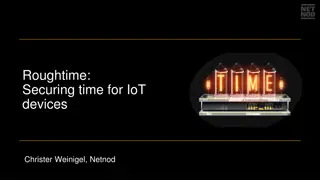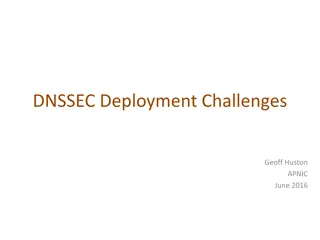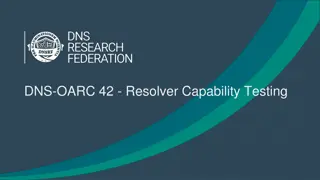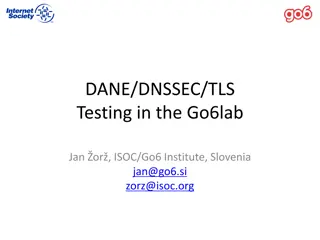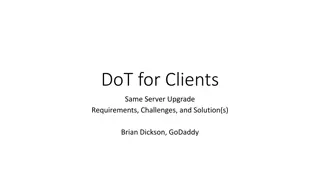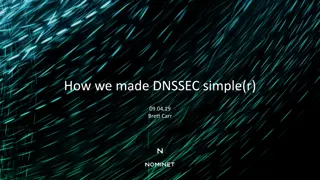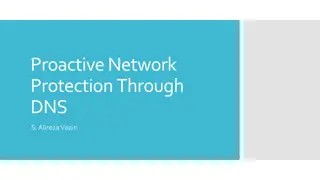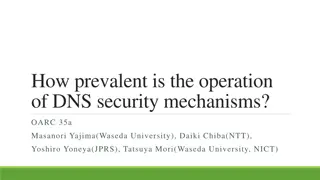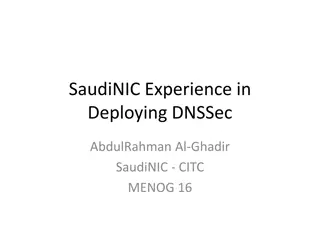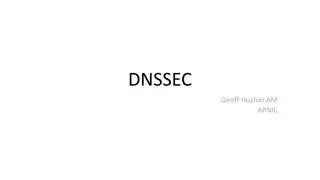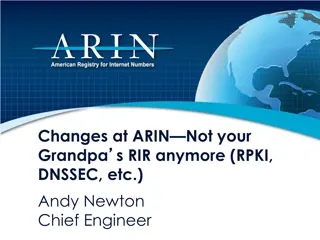Roughtime: Securing time for IoT devices
Accurate time is crucial for security protocols like DNSSEC and TLS in IoT devices. Roughtime protocol, with improved accuracy and security features, provides a solution for securing time in resource-constrained environments. The protocol addresses the bootstrapping problem and allows for microsecon
1 views • 8 slides
Challenges Faced in DNSSEC Deployment by Geoff Huston at APNIC June 2016
Geoff Huston addresses the challenges of DNSSEC deployment, discussing turning on validation in Bind configurations, reasons why it may be perceived as difficult, and the importance of DNSSEC in enhancing security within the DNS. Despite concerns about increased resolution time and limited signed na
0 views • 14 slides
DNS Research Federation: Advancing Understanding of Cybersecurity Impact
The DNS Research Federation, a UK non-profit organization, aims to advance the understanding of the Domain Name System's impact on cybersecurity, policy, and technical standards through education, research, and improved data access. Motivated by the need to measure resolver capabilities, they have d
0 views • 17 slides
Exploring DANE, DNSSEC, and TLS in Go6Lab
Delve into the implementation of DANE, DNSSEC, and TLS protocols at Go6Lab, a testing facility affiliated with ISOC/Go6 Institute in Slovenia. The setup includes DNSSEC implementation with PowerDNS and OpenDNSSEC, DANE experimentation with Postfix servers, and verification processes for TLS certific
0 views • 36 slides
Enhancing WHOIS Updates with DNSSEC, ASPLAIN, and Abuse Contact Implementation
Explore the latest updates in WHOIS, including DNSSEC deployment, ASPLAIN support, and abuse contact policies. Learn about DNSSEC deployment plans, ASPLAIN formats, and recommendations for abuse handling. Stay informed on domain security and network contact protocols.
0 views • 22 slides
Upgrade Requirements, Challenges, and Solutions for Same-Server DoT Implementation
Explore the transition from Do53 to DoT without changing resolvers, addressing challenges in DNS resolvers, TLS standards, and forwarder complications. Discover partial solutions through DANE TLSA certificates, DNS zone publishing, and DNSSEC trust anchors for enhanced security and upgrade process e
0 views • 14 slides
Apache Traffic Control Update Highlights
Apache Traffic Control provides insights into recent changes and upcoming developments, including Traffic Router updates, DNSSEC implementation, monitoring changes, and roadmap fixes. Stay informed about the project's progress and future plans.
0 views • 8 slides
Evolution of DNSSEC Implementation at Nominet
This content details the evolution of DNSSEC implementation at Nominet, covering key milestones from initial infrastructure deployment in 2008 to the adoption of a new approach in 2016. It discusses the challenges faced, technology used over the years, and the transition to a new DNSSEC approach in
0 views • 8 slides
Understanding Domain Names for Authoritative DNS Servers
Researchers need to accurately define the types of authoritative DNS servers they sample when measuring server properties. This study focuses on collecting domain names used for web servers to assess typical domain name characteristics, highlighting the importance of accurate data for research purpo
0 views • 7 slides
Proactive Network Protection Through DNS Security Insights
Exploring proactive network protection methods using DNS, security challenges, botnet threats, firewall management, malware controls, and DNS-based malware control. Discussions on DNS security vulnerabilities, DNSSEC, threat intelligence, machine learning, and best practices like RPZ for DNS protect
0 views • 29 slides
Understanding DNS Security Mechanisms
Various DNS security mechanisms like DNSSEC, DNS Cookies, CAA, SPF, DMARC, and more are crucial in protecting against security threats targeting the DNS ecosystem. This analysis delves into the prevalence and effectiveness of these mechanisms in countering vulnerabilities such as cache poisoning, am
0 views • 29 slides
SaudiNIC's Experience in Deploying DNSSEC
SaudiNIC embarked on a comprehensive journey to deploy DNSSEC, starting with observing its growth and conducting in-depth studies on pioneer implementations worldwide. The project involved creating a startup team, drafting procedures, conducting workshops, and enabling DNSSEC on various platforms. K
0 views • 16 slides
Understanding DNSSEC: Adding Digital Signatures to DNS Responses
DNSSEC (Domain Name System Security Extensions) allows for the addition of digital signatures to DNS responses, ensuring the authenticity, completeness, and currentness of the data received by a client. By validating the digital signature, clients can trust the response received is genuine and unalt
0 views • 27 slides
Evaluation of Ed25519 Cryptography Performance in DNSSEC Validation
Edwards Curve Cryptography, specifically the Ed25519 algorithm, offers faster performance and high crypto density compared to other algorithms. This evaluation study compares key sizes, processing times, and validation support for Ed25519, ECDSA P-256, RSA-2048, and RSA-4096 in DNSSEC validation sce
0 views • 19 slides
Internet Society Armenia's Role in Managing and Enhancing Armenia's DNS Infrastructure
Internet Society Armenia (ISOC.AM) actively manages Armenia's country code top-level domain (ccTLD) and plays a crucial role in ensuring the stability, resilience, and security of the country's DNS servers. Through partnerships with organizations like ICANN and RIPE NCC, ISOC.AM oversees the operati
0 views • 23 slides
Evolution of ARIN: RPKI and DNSSEC Implementation
Explore the transformation at ARIN as it embraces RPKI and DNSSEC technologies. Discover the significance of DNSSEC and RPKI, the changes needed for DNSSEC deployment, and the functionalities of RPKI in securing network resources. Dive into the critical role these technologies play in enhancing rout
0 views • 46 slides
